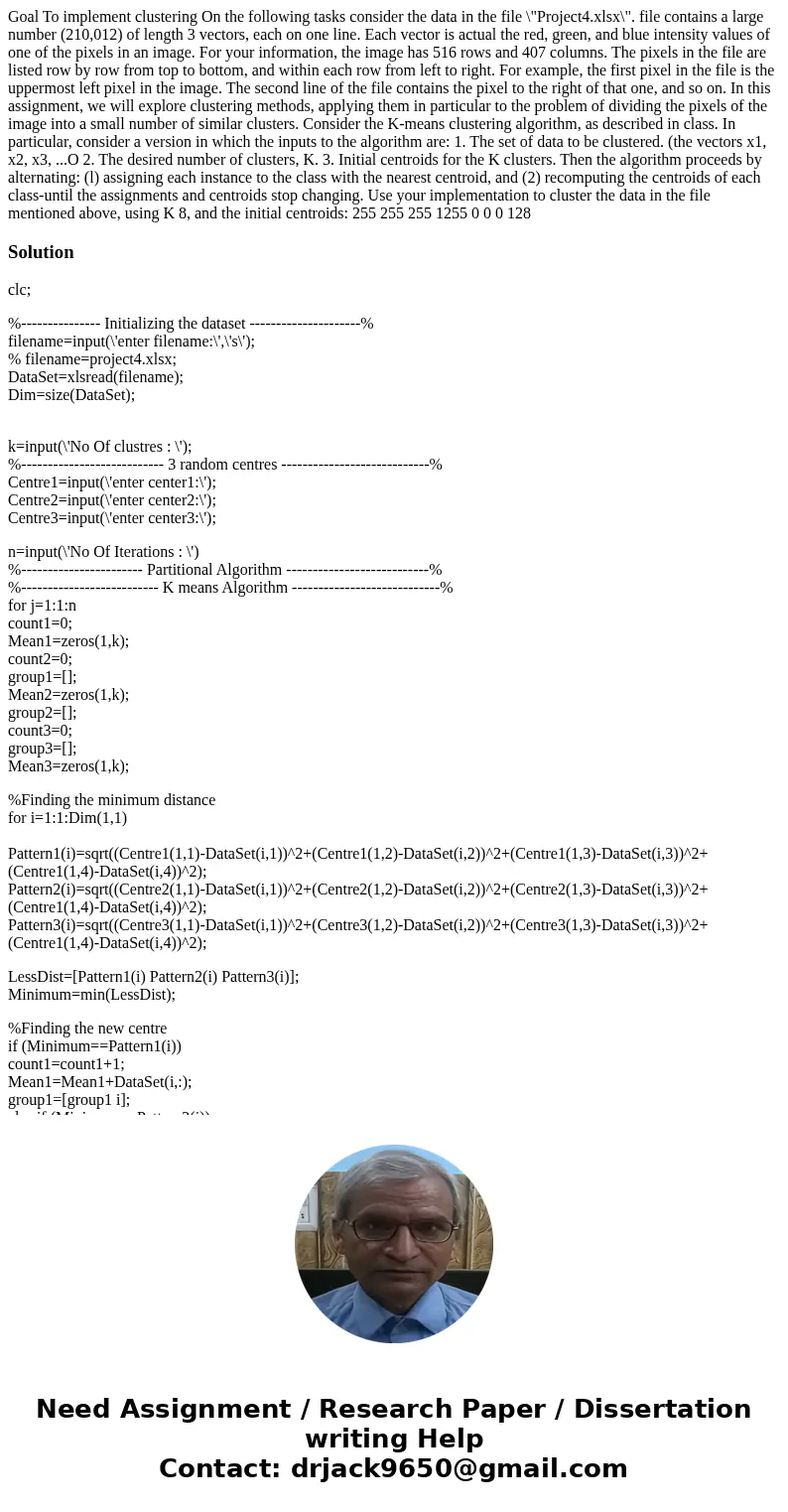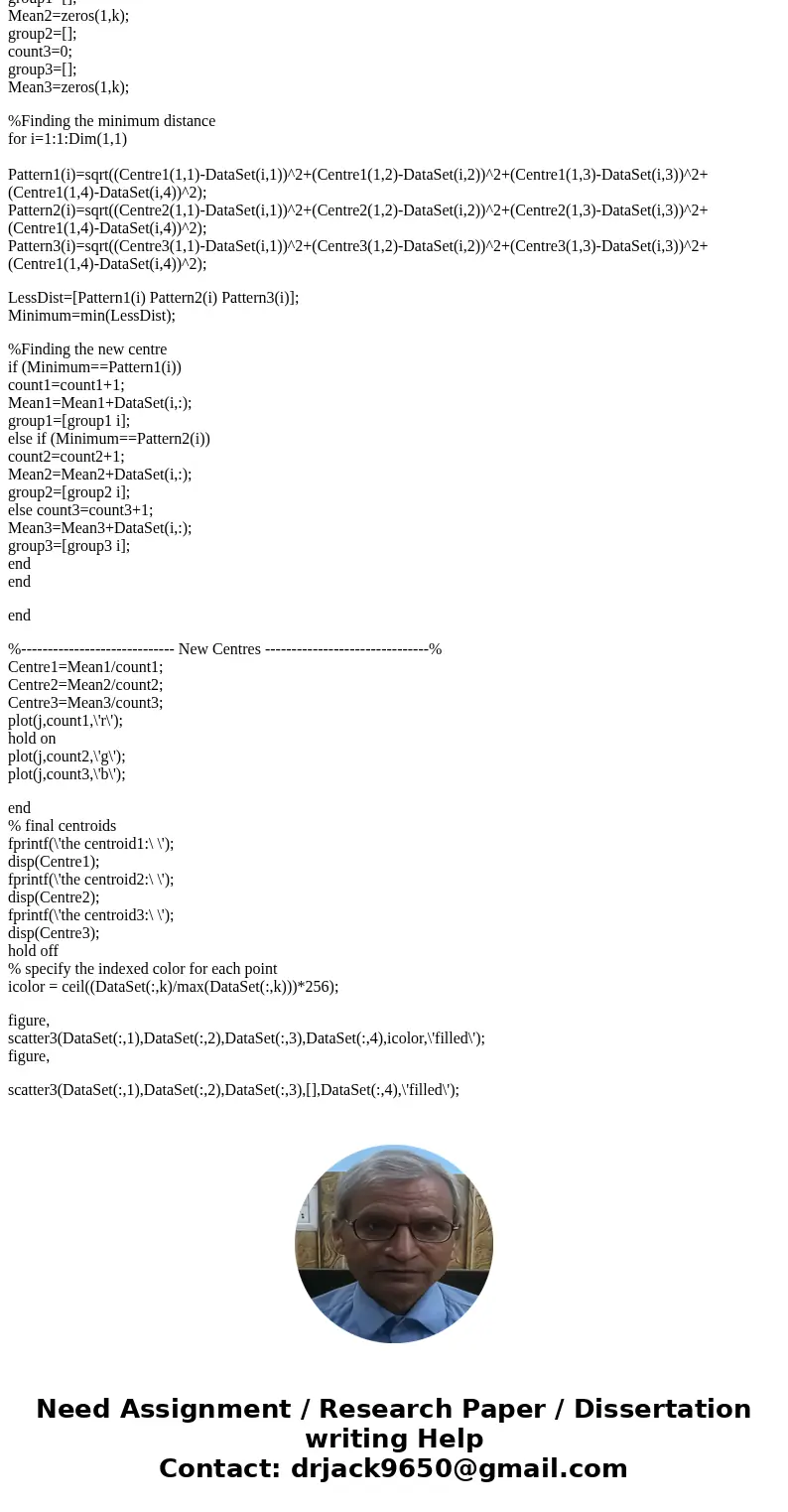Goal To implement clustering On the following tasks consider
Solution
clc;
%--------------- Initializing the dataset ---------------------%
filename=input(\'enter filename:\',\'s\');
% filename=project4.xlsx;
DataSet=xlsread(filename);
Dim=size(DataSet);
k=input(\'No Of clustres : \');
%--------------------------- 3 random centres ----------------------------%
Centre1=input(\'enter center1:\');
Centre2=input(\'enter center2:\');
Centre3=input(\'enter center3:\');
n=input(\'No Of Iterations : \')
%----------------------- Partitional Algorithm ---------------------------%
%-------------------------- K means Algorithm ----------------------------%
for j=1:1:n
count1=0;
Mean1=zeros(1,k);
count2=0;
group1=[];
Mean2=zeros(1,k);
group2=[];
count3=0;
group3=[];
Mean3=zeros(1,k);
%Finding the minimum distance
for i=1:1:Dim(1,1)
Pattern1(i)=sqrt((Centre1(1,1)-DataSet(i,1))^2+(Centre1(1,2)-DataSet(i,2))^2+(Centre1(1,3)-DataSet(i,3))^2+(Centre1(1,4)-DataSet(i,4))^2);
Pattern2(i)=sqrt((Centre2(1,1)-DataSet(i,1))^2+(Centre2(1,2)-DataSet(i,2))^2+(Centre2(1,3)-DataSet(i,3))^2+(Centre1(1,4)-DataSet(i,4))^2);
Pattern3(i)=sqrt((Centre3(1,1)-DataSet(i,1))^2+(Centre3(1,2)-DataSet(i,2))^2+(Centre3(1,3)-DataSet(i,3))^2+(Centre1(1,4)-DataSet(i,4))^2);
LessDist=[Pattern1(i) Pattern2(i) Pattern3(i)];
Minimum=min(LessDist);
%Finding the new centre
if (Minimum==Pattern1(i))
count1=count1+1;
Mean1=Mean1+DataSet(i,:);
group1=[group1 i];
else if (Minimum==Pattern2(i))
count2=count2+1;
Mean2=Mean2+DataSet(i,:);
group2=[group2 i];
else count3=count3+1;
Mean3=Mean3+DataSet(i,:);
group3=[group3 i];
end
end
end
%----------------------------- New Centres -------------------------------%
Centre1=Mean1/count1;
Centre2=Mean2/count2;
Centre3=Mean3/count3;
plot(j,count1,\'r\');
hold on
plot(j,count2,\'g\');
plot(j,count3,\'b\');
end
% final centroids
fprintf(\'the centroid1:\ \');
disp(Centre1);
fprintf(\'the centroid2:\ \');
disp(Centre2);
fprintf(\'the centroid3:\ \');
disp(Centre3);
hold off
% specify the indexed color for each point
icolor = ceil((DataSet(:,k)/max(DataSet(:,k)))*256);
figure,
scatter3(DataSet(:,1),DataSet(:,2),DataSet(:,3),DataSet(:,4),icolor,\'filled\');
figure,
scatter3(DataSet(:,1),DataSet(:,2),DataSet(:,3),[],DataSet(:,4),\'filled\');


 Homework Sourse
Homework Sourse